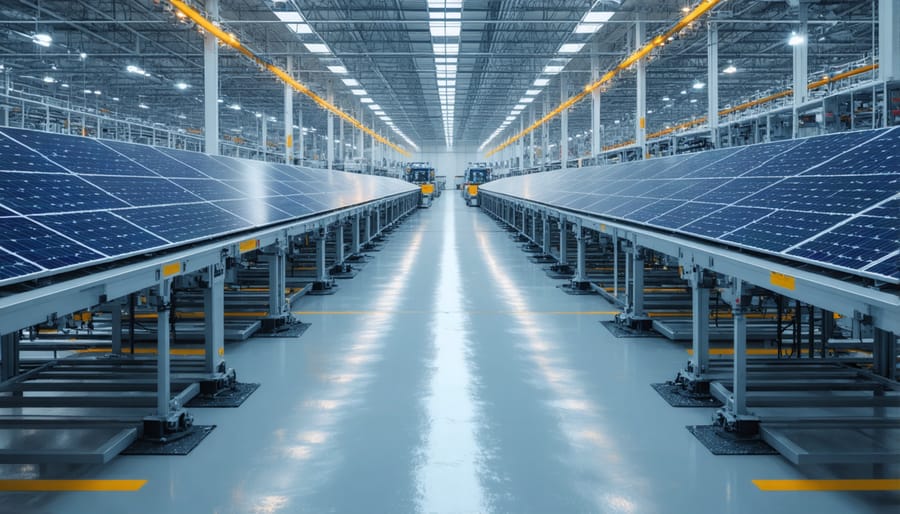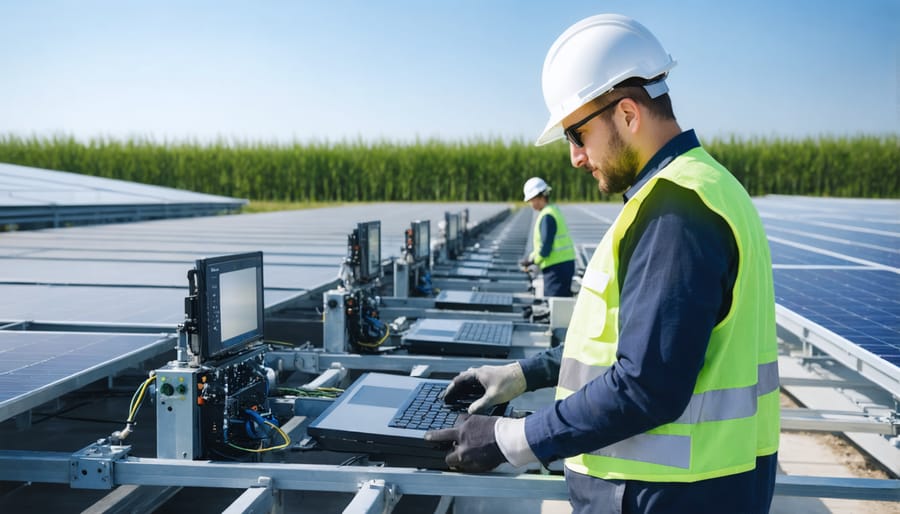How Solar Panel Recycling Facilities Are Revolutionizing Clean Energy’s Future

As Europe’s solar energy capacity continues to expand exponentially, a critical challenge emerges: managing the end-of-life cycle of photovoltaic panels. Solar panel recycling facilities stand at the forefront of this environmental imperative, transforming what could become 78 million tonnes of waste by 2050 into valuable recoverable materials. These specialized centers are revolutionizing the renewable energy sector by recovering up to 95% of solar panel components, including precious metals, glass, and silicon cells.
The surge in solar installations across European nations has catalyzed the development of sophisticated recycling infrastructure, with facilities implementing cutting-edge thermal, mechanical, and chemical processes. These advanced recycling centers not only prevent hazardous materials from entering landfills but also contribute to a circular economy by reintroducing recovered materials into the manufacturing stream.
As the solar industry matures, these facilities play an increasingly vital role in sustainable energy development. They represent the crucial final link in solar power’s lifecycle, ensuring that renewable energy truly lives up to its name by minimizing environmental impact and maximizing resource efficiency. For European businesses and homeowners investing in solar technology, understanding the capabilities and importance of these recycling facilities becomes essential for making informed decisions about their energy future.
The Rise of European Solar Panel Recycling Centers
State-of-the-Art Processing Technologies
Modern solar panel recycling facilities employ sophisticated technologies to maximize material recovery through the solar panel recycling process. At the forefront of these innovations is automated delamination technology, which efficiently separates the various layers of solar panels without damaging valuable components.
Advanced thermal processing units operate at precisely controlled temperatures to remove the ethylene vinyl acetate (EVA) layer, allowing for clean separation of glass and silicon cells. This process achieves a remarkable 95% recovery rate for glass components, while specialized optical sorting systems ensure maximum purity of recovered materials.
Cutting-edge electrostatic separation technology enables the efficient recovery of silver and copper from conductive elements, while innovative hydrometallurgical processes extract precious metals with minimal environmental impact. These facilities also utilize advanced crushing and sorting systems equipped with artificial intelligence to identify and separate different materials with unprecedented accuracy.
Water-based processing technologies have evolved to become more efficient, using closed-loop systems that recycle up to 95% of process water. This significantly reduces the environmental footprint of recycling operations while maintaining high recovery rates for silicon and other semiconductor materials.
Recent developments in chemical processing allow for the recovery of high-purity silicon, which can be directly reintegrated into new solar panel production. European facilities are particularly notable for their implementation of robotics and automation in the dismantling process, ensuring worker safety while increasing processing efficiency.
These state-of-the-art technologies not only maximize material recovery but also ensure that recycled components meet the stringent quality standards required for reuse in new solar panel manufacturing.

Material Recovery Rates
Modern solar panel recycling facilities achieve impressive material recovery rates, with leading European centers recovering up to 95% of materials from end-of-life panels. Glass, which comprises approximately 75% of a typical solar panel, sees the highest recovery rate at 95-99%, making it readily available for new panel production or other glass applications.
Aluminum frames are completely recoverable, with a near 100% recovery rate, while silicon cells can be recovered at rates between 85-90%. The process extracts valuable metals like silver, copper, and lead with efficiency rates ranging from 80-95%, depending on the specific material and recycling technology employed.
Advanced recycling processes have significantly improved the recovery of specialty materials such as silver paste and semiconductor materials, reaching recovery rates of 80-85%. These materials, though present in smaller quantities, represent significant economic value in the recycling chain.
European facilities utilizing thermal and mechanical recycling methods achieve particularly high success rates with silicon recovery, enabling the reclaimed material to re-enter the solar manufacturing supply chain. The recovery of junction boxes and connecting wires yields approximately 90% of copper and other conductive materials, contributing to the circular economy of solar technology.
These recovery rates continue to improve as facilities invest in innovative separation technologies and refined processing methods, ensuring maximum material reclamation while maintaining high purity levels essential for reuse in new solar panels.

Environmental Impact and Sustainability Benefits
Carbon Footprint Reduction
Solar panel recycling facilities play a crucial role in reducing carbon emissions throughout the solar industry lifecycle. Recent studies indicate that recycling one tonne of solar panels saves approximately 1.2 tonnes of CO2 emissions compared to manufacturing new panels from raw materials. In European facilities, the comprehensive recycling process prevents roughly 96,000 tonnes of CO2 emissions annually.
The environmental impact becomes even more significant when considering the cumulative effect. By recovering and reprocessing materials like silicon, glass, and aluminum, these facilities reduce the energy-intensive mining and processing of virgin materials. Advanced recycling technologies in European facilities achieve material recovery rates of up to 95%, translating to a carbon footprint reduction of 75-85% compared to conventional disposal methods.
Furthermore, the transportation emissions associated with material sourcing are substantially reduced through local recycling networks. European facilities strategically positioned near solar installation hubs minimize logistics-related carbon emissions by an average of 40% compared to long-distance material transportation.
Resource Conservation
Solar panel recycling facilities play a crucial role in recovering valuable materials that would otherwise be lost to landfills. Through advanced recycling processes, these facilities successfully extract precious metals like silver, copper, and aluminum from end-of-life panels. Silicon, the primary component of photovoltaic cells, is also carefully recovered and refined for reuse in new solar panels or other electronics.
The recovery rates are particularly impressive, with up to 95% of semiconductor materials and 90% of glass being successfully reclaimed. In modern European facilities, sophisticated automated systems separate and sort materials with remarkable precision, ensuring maximum resource conservation. The recovered aluminum frames and junction boxes are directly reusable in manufacturing, while extracted silver and copper find applications across various industries.
This systematic recovery not only preserves finite resources but also reduces the environmental impact of raw material extraction. For instance, recycling one tonne of solar panels can recover approximately 800kg of glass and 140kg of aluminum frame materials. The conservation of these materials significantly reduces the energy and resources required for new panel production, creating a more sustainable circular economy in the solar industry.
Economic Opportunities in Solar Recycling
Job Creation and Skills Development
The solar panel recycling industry is emerging as a significant employer across Europe, creating diverse job opportunities in technical and operational roles. Skilled technicians, process engineers, and material scientists are in high demand to operate sophisticated recycling equipment and optimize recovery processes. The sector also generates positions in logistics, quality control, and facility management.
Training programs and apprenticeships are being developed in partnership with technical schools and universities to build a qualified workforce. These initiatives focus on developing expertise in advanced recycling technologies, materials handling, and sustainable practices. The industry is particularly attractive to young professionals interested in combining technical skills with environmental stewardship.
As the sector expands, it’s estimated that for every 1,000 tonnes of processed panels, approximately 15 new permanent jobs are created, contributing to local economic growth and the green economy transition.

Solar panel recycling facilities stand as crucial pillars in Europe’s renewable energy ecosystem, bridging the gap between sustainable power generation and responsible waste management. These advanced centres ensure that end-of-life solar panels contribute to a circular economy rather than becoming environmental burdens. By recovering valuable materials and preventing hazardous substances from entering landfills, these facilities play a vital role in maintaining the green credentials of solar energy. The growing network of recycling centres across Europe demonstrates our commitment to long-term sustainability and responsible resource management. As solar installations continue to increase, these facilities will become even more essential, ensuring that renewable energy remains truly sustainable throughout its entire lifecycle. Their operation represents a critical investment in our environmental future, making solar power a truly circular solution for generations to come.
Leave a Reply